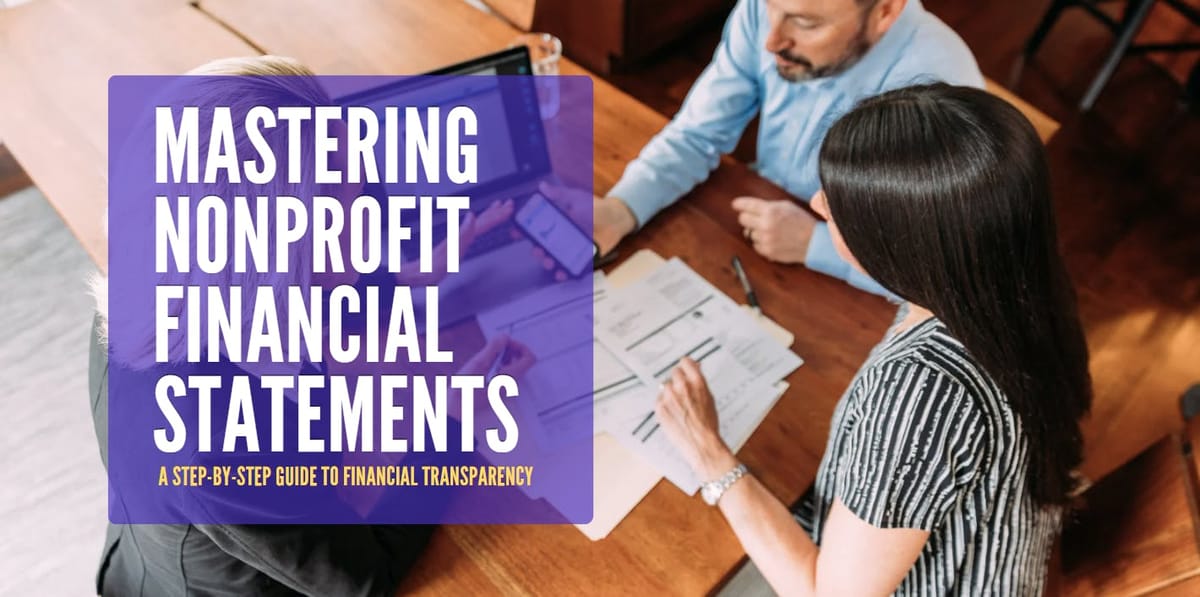Mastering Nonprofit Financial Statements: A Step-by-Step Guide (+ template)
Learn to create nonprofit financial statements for transparency and donor trust with our step-by-step guide and template.

Here's what you need to know about nonprofit financial statements:
- They're crucial for transparency, compliance, and decision-making
- There are 4 key statements:
- Statement of Financial Position
- Statement of Activities
- Statement of Cash Flows
- Statement of Functional Expenses
- They differ from for-profit statements in focus and categorization
- Creating them involves collecting data, following GAAP rules, and using the right software
- Good practices include consistency, clarity, and following IRS guidelines
- Use them to improve your nonprofit's performance and build donor trust
This guide will walk you through creating each statement, offer best practices, and provide a template to get you started.
Quick Comparison: Nonprofit vs. For-Profit Financial Statements
| Aspect | Nonprofits | For-Profits |
|---|---|---|
| Purpose | Benefit society | Generate profit |
| Financial Focus | Donor accountability | Shareholder profitability |
| Revenue Use | Specific fund categories | Business discretion |
| Tax Status | Tax-exempt, Form 990 | Taxed on profits |
| Key Statements | 4 (including Functional Expenses) | 3 (excluding Functional Expenses) |
| Net Asset Classification | With/Without Donor Restrictions | N/A (Uses Equity) |
Related video from YouTube
Nonprofit vs. For-Profit Financial Statements
Nonprofits and for-profits have different goals, and it shows in their financial statements.
The main difference? Nonprofits focus on mission and accountability. For-profits aim for profit.
Here's a quick comparison:
| Aspect | Nonprofits | For-Profits |
|---|---|---|
| Purpose | Benefit society | Generate profit |
| Financial Focus | Donor accountability | Shareholder profitability |
| Revenue Use | Specific fund categories | Business discretion |
| Tax Status | Tax-exempt, Form 990 | Taxed on profits |
Nonprofits use fund accounting to track money use. They categorize funds based on donor restrictions. For-profits? They use money as they see fit.
4 Key Nonprofit Financial Statements
1. Statement of Financial Position
Like a balance sheet. Shows what the nonprofit owns and owes.
2. Statement of Activities
Similar to an income statement. Shows revenue and expenses.
3. Statement of Cash Flows
Tracks cash movement in and out of the organization.
4. Statement of Functional Expenses
Unique to nonprofits. Breaks down expenses by program, administration, and fundraising.
For-profits typically use the first three, with different names.
A big difference? How they classify net assets. Nonprofits use two categories:
- Net Assets Without Donor Restrictions
- Net Assets With Donor Restrictions
This shows which funds are free to use and which have specific donor-set purposes.
Nonprofits must follow GAAP and IRS rules. Why? To keep their financial documents clear and trustworthy for donors, lenders, and grantors.
How to Create Nonprofit Financial Statements
Creating nonprofit financial statements doesn't have to be a headache. Here's how to do it:
1. Collect Financial Data
First, gather all your financial records. This includes bank statements, donation records, expense receipts, grant docs, and payroll info.
Pro tip: Use accounting software like QuickBooks or Aplos. It'll make your life WAY easier.
2. Make the Statement of Financial Position
This statement shows what you own and owe. Here's the breakdown:
- List assets (most liquid first)
- List liabilities
- Calculate net assets (assets minus liabilities)
| Assets | Liabilities | Net Assets |
|---|---|---|
| Cash | Accounts payable | Without donor restrictions |
| Accounts receivable | Loans payable | With donor restrictions |
| Investments | Deferred revenue | |
| Property and equipment |
3. Write the Statement of Activities
This one's all about revenue and expenses:
- List revenue sources
- List all expenses
- Calculate the change in net assets
Don't forget to separate items into "with donor restrictions" and "without donor restrictions" categories.
4. Build the Statement of Cash Flows
Track that cash movement:
- Start with net income from the Statement of Activities
- Adjust for non-cash items
- Account for working capital changes
- Add cash flows from investing and financing
Organize into operating, investing, and financing activities.
5. Prepare the Statement of Functional Expenses
Break down expenses by function:
- List all expenses
- Categorize as program, management, or fundraising
- Calculate totals for each category
| Expense | Program | Management | Fundraising |
|---|---|---|---|
| Salaries | 70% | 20% | 10% |
| Rent | 60% | 30% | 10% |
| Supplies | 80% | 15% | 5% |
6. Review and Finalize
Before you hit submit:
- Double-check for accuracy
- Ensure consistency across statements
- Get a second pair of eyes on it
- Consider an external audit for extra credibility
And there you have it! You're now ready to create rock-solid nonprofit financial statements.
Good Practices for Financial Reporting
Keep Reporting Methods the Same
Stick to one accounting method. It's that simple. Why? It helps people understand your finances better over time.
Think about it: if you suddenly change how you count expenses, it might look like your costs dropped out of nowhere. That's confusing for everyone.
"Create a financial policies document. Review it yearly. It's your roadmap for consistent accounting."
Make Reports Clear and Open
Clear reports = trust. Here's how to do it:
- Break down big categories
- Use simple words
- Explain complex stuff
Look at this cash breakdown:
| Category | Amount |
|---|---|
| Cash - Operating | $85,000 |
| Cash - Reserve | $50,000 |
| Cash - Program Restricted | $120,000 |
| Total Cash | $255,000 |
Way better than just saying "Cash: $255,000", right?
Follow GAAP and IRS Rules

GAAP and IRS rules aren't optional. They're a MUST. Why?
- Keeps your reporting accurate
- Protects your tax-exempt status
- Makes donors trust you more
GAAP says to split net assets two ways:
- Without Donor Restrictions
- With Donor Restrictions
Do it. It's important.
Remember: Form 990 is public. Donors look at it. Get it right.
Using Financial Statements to Improve Your Nonprofit
Financial statements aren't just boring paperwork. They're powerful tools to boost your nonprofit's performance. Here's how to make them work for you:
Make Better Decisions with Financial Data
Your financial statements are a goldmine of insights. Use them to:
1. Set smart goals
Look at your Statement of Activities. It shows what you've achieved before. Use it to set realistic targets.
Let's say your donor retention was 35% last year. Aim for 40% this year. Check your progress every month to stay on track.
2. Spot trends and act fast
Your Statement of Cash Flows is like a financial weather report. It shows where money flows in and out. Use it to:
- Find donation patterns
- Cut costs when things are slow
- Plan for big expenses
3. Balance your budget
The Statement of Functional Expenses helps you spend wisely. Aim for this mix:
| Expense Type | Target % |
|---|---|
| Programs | 65-75% |
| Admin | 15-20% |
| Fundraising | 10-15% |
Tweak these based on what your nonprofit needs.
Show Donors Their Impact
Donors want to know their money matters. Here's how to prove it:
- Make reports crystal clear
Turn complex data into easy-to-get info. Use charts and graphs to show:
- How you use donations
- How well your programs work
- How you've grown year over year
- Tell stories with numbers
Mix financial data with real impact. Like this:
"We raised 20% more this year. That meant 1,000 extra meals for homeless folks in our city."
- Be honest about tough times
If money's tight, say so. But also share your plan to fix it. Honesty builds trust.
Build Trust, Raise More
When donors trust you, they give more. Here's how to earn that trust:
- Keep donors in the loop
Send out financial updates every few months. Include:
- Key numbers (like how much you spend on programs)
- Recent wins
- What's coming up next
- Show it all on your website
Put a dashboard on your site. Update it monthly with:
- Total donations
- People you've helped
- Progress on your goals
- Mix numbers and stories
Take a tip from GiveCampus: pair financial data with stories about the people you help. It shows donors their real impact.
- Ask what donors want to know
Send out surveys. Ask donors what financial info they care about. Then give it to them.
Clear, honest financial reports make donors confident. And confident donors give more.
Financial Statement Template for Nonprofits
Want to simplify your nonprofit's financial reporting? We've got a template that'll do the trick.
Using and Customizing the Template
Our template covers the four key nonprofit financial statements:
- Statement of Financial Position
- Statement of Activities
- Statement of Cash Flows
- Statement of Functional Expenses
Here's how to use it:
1. Get the template: Download our free template [link to template download].
2. Choose your software: Works with Google Sheets or Excel.
3. Input your data: Replace sample numbers with your org's figures.
4. Adjust as needed: Modify categories to fit your structure.
5. Review thoroughly: Ensure all calculations are correct.
Let's look at each statement:
Statement of Financial Position
Shows what you own and owe:
| Assets | Liabilities and Net Assets |
|---|---|
| Cash | Accounts payable |
| Investments | Loans |
| Property | Net assets |
Statement of Activities
Tracks income and expenses:
| Revenue | Expenses |
|---|---|
| Donations | Program costs |
| Grants | Admin expenses |
| Events | Fundraising |
Statement of Cash Flows
Displays money movement:
- Cash from operations
- Cash from investments
- Cash from financing
Statement of Functional Expenses
Breaks down costs by function:
| Expense Type | Programs | Admin | Fundraising |
|---|---|---|---|
| Salaries | |||
| Rent | |||
| Supplies |
Tip: Use this to track expenses by project or location. It'll boost your budgeting game.
Clear financial reports build donor trust. As Jitasa Group puts it:
"Donors rely on this data to make informed decisions about your nonprofit."
Conclusion
Creating and managing nonprofit financial statements isn't just about crunching numbers. It's about telling your organization's financial story accurately and clearly.
Here's what you need to do:
- Gather your financial data (and make sure it's accurate)
- Create your four main statements:
- Statement of Financial Position
- Statement of Activities
- Statement of Cash Flows
- Statement of Functional Expenses
- Double-check everything
- Use these statements to guide your decisions
But don't stop there. Keep improving your financial game:
- Stick to consistent reporting methods
- Be clear and transparent
- Follow the rules (GAAP and IRS)
- Regularly check your financial performance
- Plan for the long-term
- Set clear policies
- Use good financial software
- Get better at budgeting
- Do internal audits
Why does all this matter? It's not just about following rules. It's about building trust with your donors and making the most of every dollar to achieve your mission.
As Propel Nonprofits puts it:
"Financial policies clarify the roles, authority, and responsibilities for essential financial management activities and decisions."
In other words: Good financial management helps everyone know what they're supposed to do. And that's key to running a successful nonprofit.
FAQs
How to prepare financial statements for a non-profit organization?
Here's how to prep financial statements for your non-profit:
1. Gather all your financial data
2. Create these key statements:
- Statement of Financial Position
- Statement of Activities
- Statement of Cash Flows
- Statement of Functional Expenses
3. Double-check everything
4. Make sure you're following GAAP and IRS rules
These statements aren't just for the taxman. They're your financial story - use them to make smarter decisions and show donors you're trustworthy.
What are the four basic financial statements for a nonprofit?
Nonprofits use these four financial statements:
| Statement | What it shows |
|---|---|
| Statement of Financial Position | Assets, liabilities, net assets |
| Statement of Activities | Revenue, expenses, net asset changes |
| Statement of Cash Flows | Cash coming in and going out |
| Statement of Functional Expenses | Expenses by function |
Together, these paint a full picture of your nonprofit's financial health.
What do nonprofit financial statements look like?
Nonprofit financials are similar to for-profit ones, with a few twists:
- "Net assets" replaces "equity"
- "Support" or "contributions" often used instead of "revenue"
- Expenses grouped by function (program, management, fundraising)
The Statement of Functional Expenses is unique to nonprofits. It shows how you're spending money to fulfill your mission, broken down by both function and type of expense.

